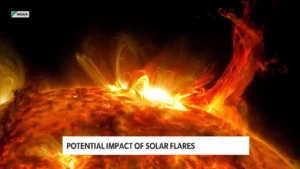
Could Solar Flares Cause A Widespread Cell Service Outage?
min read
Christina Thompson (Anchor, EarthxNews): Recently hundreds of thousands of AT&T customers had their cell phone service knocked out by a nationwide outage for over 10 hours before it was restored.
While initial reports included the possibility of solar flares being the potential cause, it was ultimately decided that the outage was unrelated to this natural occurrence. Regardless, the event reignited the conversation about the impacts of intense solar flares and bursts of radiation.
Joining us now to give a little bit more perspective on the solar flares and their potential impact on the earth is Rob Steenburgh, Space Scientist with NOAA’s Space Weather Prediction Center. Rob, thanks for coming on.
Rob Steenburgh, Space Scientist with NOAA’s Space Weather Prediction Center: Thank you for having me.
THOMPSON: So first off, what exactly is a solar flare?
STEENBURGH: Well, solar flare is a big violent release of energy on the sun’s surface and it sends out energy and that energy can be intercepted here at Earth; and it does this through radiowaves, and visible light X-rays, and so on.
THOMPSON: Can you tell us about this recent outburst of this huge solar flare that scientists says that scientists say were the most powerful since 2017?
STEENBURGH: Sure thing, it was an X6 flare, uh, so our flares are rated on a scale the lowest or most common flares are called C and that’s easy to remember. M are moderate flares, X are the extreme flares; so this was a an x-class flare and it’s the largest x-class flare that we’ve seen. However it’s uh totally within the normal limits of what we’d expect in a solar cycle.
THOMPSON: What kind of issues can these large flares cause here on Earth; can they impact frequencies radios, navigation, things like that..?
STEENBURGH: They sure can. The biggest impact probably is uh the impact on radio communications that uses the layer of our atmosphere called the ionosphere uh that ionosphere acts as a reflector of high frequency radio transmissions and this becomes a factor for aircraft traveling over the oceans. For instance, it can change what frequencies are available uh for the pilots to use to communicate with the controllers. That’s one aspect. Another thing it can do is produce a solar radio burst and those radio bursts, depending on the frequency they occur on, and how strong they are can disrupt communications as well on frequencies other than high frequencies. So they can affect even higher frequencies UHF and VHF that must be why some people thought that that recent AT&T outage might have been caused by a solar flare.
THOMPSON: But is this true?
STEENBURGH: That’s absolutely right that’s I think that’s the the idea that some people thought however flares typically only last for minutes to a few hours unless you have subsequent flares afterwards and we looked at the radio emissions from this flare and compared them to the cell phone frequencies and there were no emissions on the cell phone frequencies that would be strong enough to cause a problem.
So that was the first you know tip off that we had that hey this is you know not space weather related and AT&T published a statement that’s that basically said that it was uh basically a malfunction uh of some process they were carrying out. Once once I learned it wasn’t space weather I was back to work looking good to go, it’s not us.
THOMPSON: What’s the predictions for forecasts or more large scale solar solar flares? Should anyone be worried about these maybe um upping in frequency over the next few years…?
STEENBURGH: Yes, well we’re heading towards solar max we expect to to peak within probably the next year or two um and with that will come more flares and we’ll see more X flares. I’m sure uh we’ll see more um you know interference on high frequencies uh which also affects amateur radio operators um and we’ll see more of the events that cause geomagnetic storm.
So with a flare sometimes you get an ejection of the solar atmosphere part of the sun actually is blown off into outer space and sometimes those can come to Earth and when they do those are the things that produce geomagnetic storms and give you an opportunity to see the northern lights; uh we call those coronal mass ejections or CMEs for short, and they’re the things that trigger the geomagnetic storm.
So we’ll see more of those as well a lot of topics covered!
THOMPSON: Thank you so much for breaking it all down for us helping us lay men understand what happens out there in space. It was very helpful, so Rob Steenburgh with NOAA, thank you!
STEENBURGH: Thank you for having me and yeah we’ve got a whole team of people who do this every day so uh we’re watching out for you!
We appreciate it!
